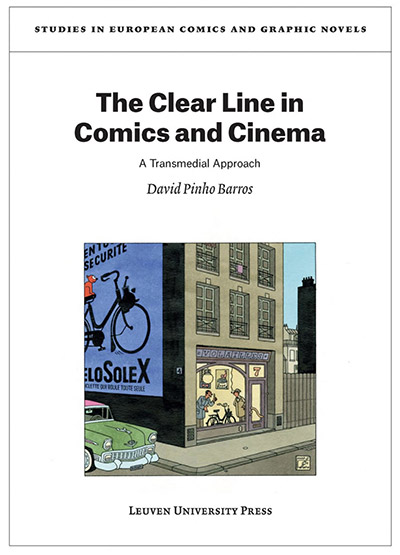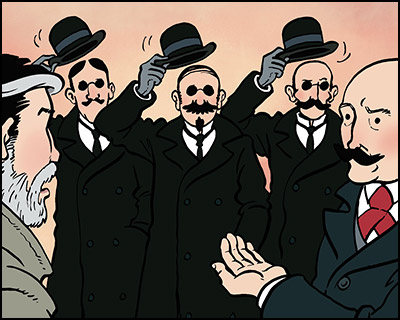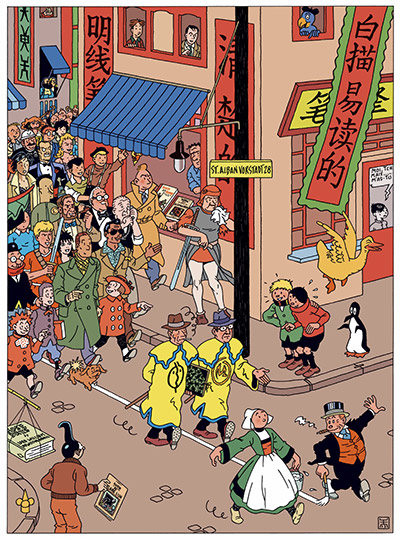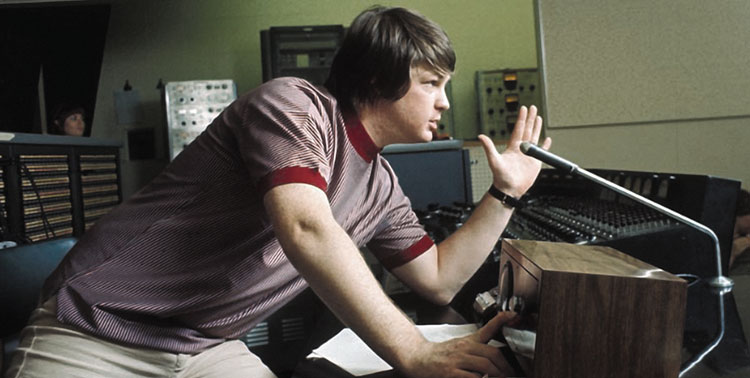
This blog began in 1997 as a single news page called Nucelus. In 2005, during a long wait to move into a new house, I decided to learn some php and MySQL and write my own blogging system, which became inkyBlog and which now powers this, my own Webbledegook blog.
Thank you to my brother, Murray Ewing, for help with some of the more challenging aspects!
I have to say that these days I do not go looking for reviews of my work - positive or negative. Positive ones make me squirm and feel unworthy, and negative ones make me feel bad - neither is enjoyable (though I am very grateful for the positive ones).
The book looks really interesting, despite the fact I'm a little wary of the overanalysing of an author's works. But the intersection of clear line comics, a highly narrative form of storytelling, and parallel philosophies in film is quite fascinating (and one of the directors Barros looks at is Yasujiro Ozu, a favourite of mine).

cover for The Clear Line in Comics and Cinema, art by Joost Swarte
I am jumping the gun, I have not read it yet, though I do intend to. But I did screw up my courage and skim-read the section on The Rainbow Orchid, and here I saw a statement that I want to address as I do feel it misrepresents my motivations.
Firstly I should say I'm a great believer in the idea that once you've finished a work and it goes out into the world, it is no longer your possession. It belongs to whoever picks it up and reads it, and they can bring all their thoughts, beliefs, prejudices, biases and feelings to that work and interpret it however they want. They may not align with the author's, and they may read things into the story the author never intended or meant, and that has to be the way it is.
In chapter 3, 'The clear line after Tintin et les Picaros', Barros says: "I propose to look at two [authors] in particular: the French Olivier Marin and the British Garen Ewing. In both cases, their use of the clear line is mostly a consequence of a selling strategy, which, by proclaiming a graphic affiliation with the classic series, aims at attracting the nostalgic reader and, simultaneously, surprising him or her with contemporary representations of topics which were proscribed in the youth magazines of the likes of Tintin, such as highly eroticised renderings of the female body."
That last bit about the "female body" refers to Olivier's work more than mine, but I'm a little perturbed that isn't clear, especially as I made the decision not to sexualise any aspect of the characters or story in that book. And that idea is connected to the main point - that The Rainbow Orchid uses the clear line style as a 'selling strategy'.
This could not be further from the reality of the comic's origins. Back in the 1990s I was looking more seriously at working in comics. I had done a lot of fanzine work and felt my art was improving so I was getting a portfolio together and going to comics shows and meeting professional artists and editors.
Thanks to this I went through a process of realisation - I didn't think I actually wanted to get into professional comics after all. While I had enjoyed working with various writers, I knew the main thing I liked doing was creating and writing stories, and being the illustrator for someone else's vision did not fulfil that aspiration. And this wasn't a reaction to a lack of success, in fact it came about when I started to have some succes - having work accepted for Heartbreak Hotel, doing a full US superhero comic for Blue Comet Press, and particularly after having an enthusiastic response at a convention with a DC editor and an invitation to contact them for work on a new black and white imprint they were starting.
I never followed up on that last one because I was coming to the realisation that this was not what I wanted. I found drawing hard, I wasn't naturally talented and I wasn't fast (essential for comics) - but I did enjoy it, and I really loved the comics medium. After some soul-searching I decided to concentrate on a career as an illustrator and leave the comics as a spare-time pursuit, something I could just enjoy for my own gratification.

Mr Tardy, Mr Tardy and Mr Tardy, The Brambletye Box by Garen Ewing
What did I enjoy? Big fat escapist adventure stories! Also I wanted an antidote to all the gritty 'adult' comics that were everywhere at the time. My art was naturally cleaning up, particularly after adapting The Tempest I was appreciating simplicity, reduction and clarity. I'd had my first paying job, for a newspaper, and was able to complete my collection of Tintin books - the staple (along with Asterix) of my comic-reading childhood. More importantly I had just discovered Blake and Mortimer, and had bought my first Jacques Tardi book.
So, I'd decided. I would not work towards a career in mainstream comics but instead concentrate on working as a commercial illustrator, the comics would be purely for my own enjoyment, self-published for whatever small readership would gather in front of me.
Things changed when the internet arrived. I got on it in about 1998 and started putting The Rainbow Orchid up as part of my website in about 2005. Without much publicity (I was still treating it as a hobby) it started to gain traction anyway and largely thanks to some much larger web-comics coming across it and linking to it, the readership escalated.
It's another story, but this kind of exposure lead to an agent and eventual mainstream book publication and, of course, vast wealth (yeah, joking on that last one). I chased none of these things, they came to me, though I was very happy about it, of course.
That's an overly-long ramble to the statement that my use of the clear-line is the "consequence of a selling strategy". I do resent that idea, and it's explicitly because that makes it seem like the decision was rather a calculating scheme to elicit sales in the marketplace - the opposite of what actually happened.
I don't want to have a go at David Pinho Barros for his remark. Although I have talked about the origin of The Rainbow Orchid I can't expect him to seek out everything I've ever said. He does quote the following I wrote for my website many years ago (still there in my faq) ...
"I wanted to invoke the atmosphere I loved from European adventure albums such as Hergé's Tintin, Edgar P. Jacobs' Blake & Mortimer, Yves Chaland's Freddy Lombard, and Tardi's Adèle Blanc-Sec, to name just a few. Most British readers cite Tintin because not many other ligne claire comics have made it over from France and Belgium, but it is an entire school of comic strip storytelling with many creators working in the style, just like manga often has a certain look to it. The Rainbow Orchid has been compared stylistically to Floc'h's Trilogie Anglaise or Jacobs' La Marque Jaune. The better you know Tintin, the more apparent the differences, but I don't refute the similarities - it was a conscious decision."
... and I can certainly see how a 'conscious decision' to invoke the style of Hergé and Jacobs might be seen as a commercial choice, though actually it was merely one born out of enthusiasm for exploring the form for myself. I guess that's the bit missing - I wanted to invoke that atmosphere for myself.

Art by Exem for the Cartoonmuseum Basel
There's nothing wrong with making an artistic decision in order to maximise revenue, but it does have the feeling of an accusation, and offers the idea that money, not art, is the driving force, something that is generally frowned upon. And not that I'm against making monery off my art - far from it - and I strongly dislike the conceit that 'true art' can only go hand-in-hand with poverty.
Since having the book out, and even being lucky enough to have it appear translated in the Franco-Belgian world that inspired it, I have seen the more commercial side of the ligne claire. It certainly has an aspect of marketability in Europe. In the UK my largest audience was children (although not explicitly a children's book), whereas in France, the Netherlands and Germany, the largest audience I saw was people like myself, older, mostly male, and nostalgist collectors (not exclusively, and also not a problem by any means!).
This is partially due to the publishers, smaller, boutique publishers who cater to that audience with reprints and classic series. With a much bigger publisher in the UK (Egmont) the readership was hugely varied, children, teens, adults, quite strong in both male and female readership.
I actually suspect the style I've chosen to work in has been a hindrance in my own country, as so many people are familiar with Tintin, and nothing else, that I can appear merely as a copycat or fan-artist. While I was making Orchid I purposefully didn't look at a Tintin book - for years - wanting to develop my own ligne claire style. Of course it's always going to be compared to Tintin, and fair enough.
Now I have returned to the point I was at twenty years ago - a new Julius Chancer book and I'm doing it for myself. I haven't signed with a publisher and don't strongly mind whether I do or not - it would be preferable, of course, but I'm happily prepared to self-publish. I'm more aware of the 'clear-line scene' now, and certainly I've changed since The Rainbow Orchid, the comics scene has vastly changed, so my comics have changed.
Anyway, that answers the point I wanted to address about my book's motivations! Whether it's a wise thing to do I'm not certain, but, especially as I get older, I see my creativity as part of my identity, and feel the record should be corrected, even if just here on my blog.
I hope I haven't misinterpreted Barros's writing, and I do look forward to reading his book, which looks fascinating. I'm enormously flattered he even chose The Rainbow Orchid for inclusion, it's a privilege to be part of it whether praise or criticism. You can download the book yourself from here.
The Brambletye Box had a bit of a pause over the summer due to all kinds of things, a bit of everything in fact - illness, family stuff, work, holidays - all those ingredients of life! Some new art did go up on my Patreon page a couple of days ago, so that's the place to see anything new at the moment.


Discovering Led Zeppelin directed me to other bands, musical brethren and cousins, with Sabbath inevitably being one of those. Paranoid was my first of their albums, probably still my favourite, though I think Vol. 4 is another of their best alongside their 1970 debut, Black Sabbath.
When I started to learn bass guitar, Paranoid was the first song I worked out and learned on the instrument, going on to then learn NIB and Snowblind. We didn't do any Sabbath songs in my first group as some close friends of ours were in a Sabbath covers band, and we didn't want to stray into their territory, though I did return to Paranoid for a much later band. I also recall learning Symptom of the Universe for a pub jam night where I had to detune my bass by a whole tone so the vocalist could comfortably sing it - my E-string was like a rubber band it was so loose!
Obviously Ozzy was a massive part of the Sabbath sound, and they weren't the same when Ronnie Dio came in (as decent as his albums were), and it was more Geezer Butler and Tony Iommi who I really admired. I did have two Ozzy solo albums (1980s Blizzard of Oz, actually bought because I was interested in Lee Kerslake and Bob Daisley's contribution, both members of Uriah Heep, and 1987's Tribute), but neither got a lot of play, I must admit.
Parts of Ozzy's character were very problematic, but it's sad to see anyone decline, as he has, in recent years. How nice he had such a good send-off at the Back to the Beginning concert just a few weeks ago. I'll definitely be getting some of those early Sabbath records out for a spin over the coming days (and I've also been greatly enjoying Brown Sabbath and their cover versions in recent months).

He was a decent age, he was not in good health, but it's an enormous loss all the same - he really was one of the absolute best of the best when it came to songwriting, arranging, producing - all aspects of musical creation. Many words have been written about him, and there will be many more who will say it better than I could now.
I got into the Beach Boys in the mid-80s - I had a double tape set, the 'Very Best Of' (the one with a lady's bikini'd backside on the cover) which I listened to on rotation. In fact it will have been during the summer of '85, just before I went to live in California for a year myself.

I was attracted, at first, by the vocal harmonies, something that has steered me to much of my favourite music (Queen, Uriah Heep, ELO, a lot of classical choral music from Henry Purcell to Gabriel Fauré and more), but soon became enamoured by Brian Wilson and his creative vision in particular. I got hold of every Beach Boys recording I could, including a number of rarities and boxed sets. In 2004 I got to see him live when he performed Smile at the Royal Festival Hall - it didn't disappoint.
Once described as "the man who heard the last chords of God", he had a troubled life, but what an incredible gift to leave us mere mortals. Love and Mercy, Brian.

Recommended for ages 7+ and teens (or anyone, really!), you can book through the festival website here.
And have a look at the little video for it here.


The first appearance of Julius's SSK in 'Orchid' and the Lorraine Dietrich in 'Samurai'
In The Secret of the Samurai, which is set a couple of years earlier (when the SSK had not yet been built), Julius drove a blue Lorraine Dietrich (for which I also used a toy model for reference). But for The Brambletye Box, Jules is back with his red Mercedes.

The SSK followed by a Hispano-Suiza in The Brambletye Box
These days there is way more reference available online (I even visited an actual SSK at Beaulieu a couple of years ago), so I've been able to be a little more accurate with some of the car's details. I'm not going overboard - I don't need the drawings to take any longer than they already do. As I've improved I don't need a model for every car - Lily's gold Bentley 3-Litre is drawn with just a sheet of photo reference at hand.

Lily's gold Bentley 3-Litre
An editor once asked me what I found most difficult to draw - my answer was "cars". A month or so later I submitted the first chapter of my comic for him and there, on page one, panel one, was a big white Bentley Continental. "I thought you wanted to avoid drawing cars?", he asked. But that's kind of why I put it in there. I have this little bee in my head that says "you can draw anything", and when I know something will be difficult I find myself writing it in, almost as a challenge.

A Bentley Continental from 'Charlie Jefferson and the Tomb of Nazaleod' for The DFC
This is something that so-called 'A.I. artists' will never understand, and A.I. can never reproduce. It is not just the finished result, it is the process, the choices, the mistakes, the challenge, the struggle, the effort, the evolution - the human being - that makes the finished art. (And, still on A.I., beware the amount of A.I.-rendered cars now online - they're not accurate!)
That Bentley was more modern, and I do find them particularly hard, all curves and streamlined. 1920's cars are a little more boxy - but also more beautiful in my eyes. The SSK is a work of art.

The Mercedes SSK at Beaulieu, once owned by Sir Peter Ustinov
Only recently I discovered the SSK featured as another comic character's car of choice - or in his animated version anyway (I'm not sure about the original manga) - Lupin III drives, and regularly crashes, a yellow Mercedes SSK. This has been eclipsed somewhat by the Fiat 500 he drives in his most famous outing, Miyazaki's Castle of Cagliostro.

Lupin in his yellow SSK
I'm very happy to have that link, in a similar way to when I chose the Breguet 280T as the aircraft that takes Jules and co. to India in The Rainbow Orchid, only to discover, on a later visit to Angouleme, that this uncommon aircraft had also been featured in pioneer French comic character Bécassine's adventures (Bécassine en Aeroplane, 1930).

Bécassine with a 280T, and Nathaniel Crumpole with a 280T
Anyway, in line with this bee in my head to challenge myself, I've crazily written a car chase into The Brambletye Box (a Hispano-Suiza H6 chasing the SSK down the A22), and that's what I'm drawing at the moment. It's enjoyable - but definitely another challenge!

Now there's quite a few characters on that page (from The Brambletye Box, The Rainbow Orchid and The Secret of the Samurai) I have rewritten it so you can show and hide the various character sets from the stories - let me know if it's not working!

Logos For Shows is my little side-business of providing theatre art for schools, amateur companies and professionals to use for their show publicity. It started back in 2011 out as a reaction to seeing my Oliver! logo being stolen and used all over the place (sadly that still happens) and a chance to license my artwork and make it affordable for those on a budget.
The next thing to do is to increase the number of shows I have available. I already have a second Grease design and some Peter Pan artwork at the sketch stage, and plans for quite a few more to come - it's just a matter of making the time for it!

Actually I do have one copy left, and my plan is to do a nice drawing in it (rather than just a quick sketch) and put it on ebay in the near future as a little fund-raiser. Watch this space.
